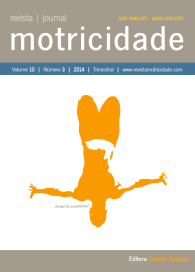The influence of gymnastics in motor coordination and reaction time in urban public bus drivers
DOI:
https://doi.org/10.6063/motricidade.2896Abstract
This study investigated the influence of labour gymnastics (LG) on bus drivers' basic skills such as reaction time and gross motor coordination. Sixty male bus drivers (37.06 ± 7.66 years old) from two bus lines in the city of Santa Maria (RS) took part of this study. The participants were split into two groups, experimental group (EG) and control group (CG). Subjects that were part of the EG took part in a LG intervention program, 2-3 times a week, over a year. Gross motor coordination was assessed by BURPEE Protocol (Johnson & Nelson, 1979), whereas reaction time by software providing a visual stimulus. Data normality was checked through Shapiro-Wilk test, which pointed to normal distribution only for the variables simple reaction time (SRT) and choice reaction time (CRT) in the EG. Therefore the non-parametric Mann-Whitney U test was selected to compare differences between groups. A statistically significant difference for gross motor coordination was found (z= −2.525, p= 0.012), suggesting the effectiveness of LG to improve motor skills. As regards SRT and CRT, no significant difference was found, in spite of better outcomes having been recorded after the LG program.
Downloads
Published
Issue
Section
License
The authors of submitted manuscripts must transfer the full copyright to Journal Motricidade / Sílabas Didáticas Editions. Granting copyright permission allows the publication and dissemination of the article in printed or electronic formats, and copyrights start at the moment the manuscript is accepted for publication. It also allows Journal Motricidade to use and commercialise the article in terms of licensing, lending or selling its content to indexation/abstracts databases and other entities.
According to the terms of the Creative Commons licence, authors may reproduce a reasonable number of copies for personal or professional purposes, but without any economic gain. SHERPA/RoMEO allows authors to post a final digital copy (post-printing version) of the article on their websites or on their institutions' scientific repository.


